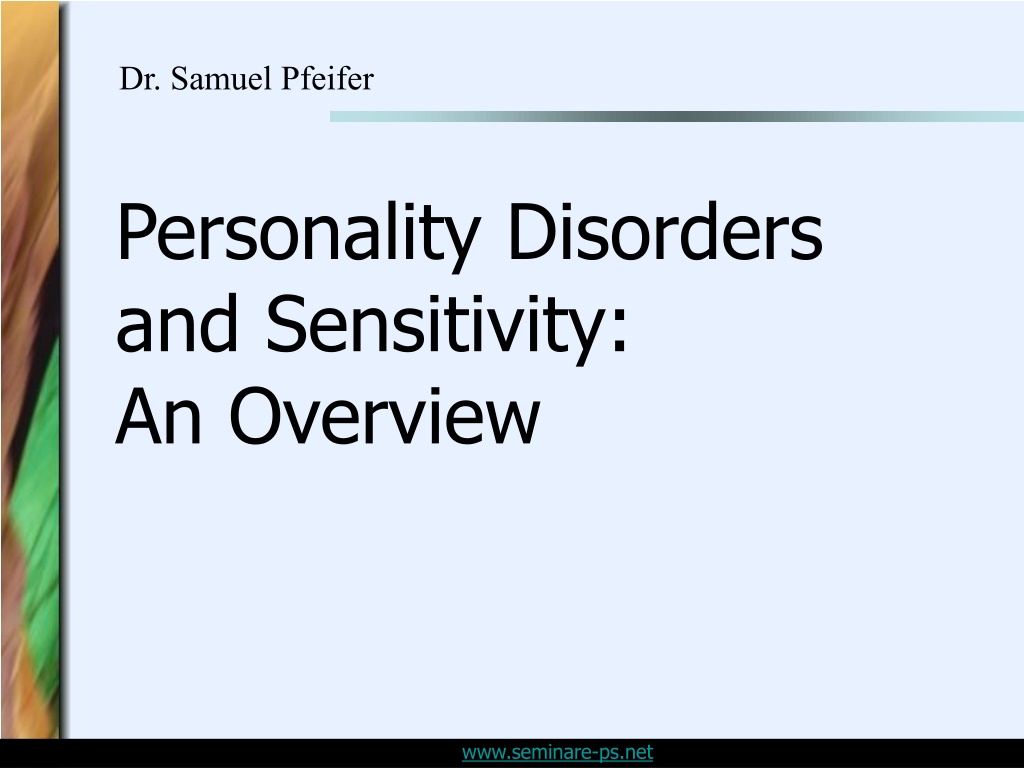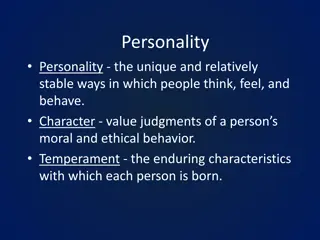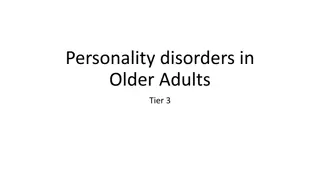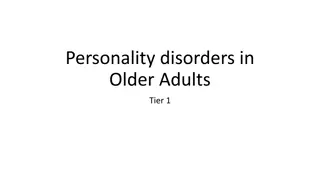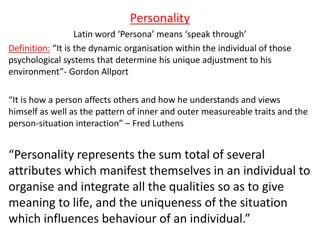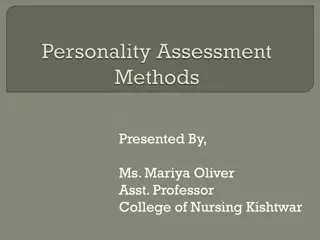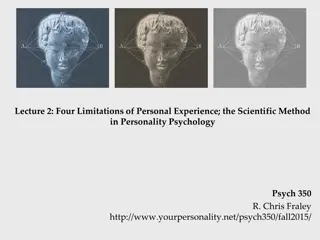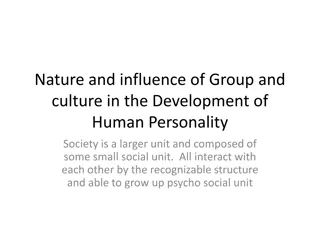Healthy Personality Development
Exploring the concept of a healthy personality and its significance in personal well-being and societal adaptation. The discussion covers different models of mental health, the purpose of personality, and the eight modalities of personal functioning that contribute to overall psychological well-being. Key aspects such as individuality, relationships, stability, and personal growth are highlighted for a better understanding of what constitutes a healthy personality.
Download Presentation

Please find below an Image/Link to download the presentation.
The content on the website is provided AS IS for your information and personal use only. It may not be sold, licensed, or shared on other websites without obtaining consent from the author.If you encounter any issues during the download, it is possible that the publisher has removed the file from their server.
You are allowed to download the files provided on this website for personal or commercial use, subject to the condition that they are used lawfully. All files are the property of their respective owners.
The content on the website is provided AS IS for your information and personal use only. It may not be sold, licensed, or shared on other websites without obtaining consent from the author.
E N D
Presentation Transcript
Dr. Samuel Pfeifer Personality Disorders and Sensitivity: An Overview www.seminare-ps.net www.seminare-ps.net
What is a healthy personality? There are many possible answers / models Excellent overview: Vaillant G.: Mental Health, American Journal of Psychiatry 2003; 160:1373 1384 Three Models: Mental Health Normality Positive Psychology Maturity www.seminare-ps.net www.seminare-ps.net
www.seminare-ps.net www.seminare-ps.net
What purpose does personality serve? for myself or for society? adaptation or creativity? my wellbeing or survival? www.seminare-ps.net www.seminare-ps.net
Creativity or Survival? www.seminare-ps.net www.seminare-ps.net
What is a healthy personality? www.seminare-ps.net www.seminare-ps.net
What is a healthy personality? SHORT FORMULA: ability to enjoy, to relate and to work. Psychologically healthy with a positive development is a person who is able to utilize eight aspects or polarities depending on life context or requirement in a way that is situational or functional. (Fiedler) www.seminare-ps.net www.seminare-ps.net
Eight Modalities of Personal Functioning Individuality, Independence. Relationship, Attachment, Security. Spontaneity, Desire for New Experiences, Instability. Stability, Self control, Security. Wellbeing, Pleasure. Allowing and accepting pain, Melancholy Actively structuring life Manipulation. Passive Receiving, letting things happen. (according to Fiedler/Millon) www.seminare-ps.net www.seminare-ps.net
Common themes in normality strength of character ability to learn from experience ability to work ability to achieve insight absence of symptoms/conflict ability to experience pleasure without conflict flexibility/ability to adjust ability to laugh ability to love another degree of acculturation www.seminare-ps.net www.seminare-ps.net
Where is the line? It s all a matter of degree and which traits: e.g. To be a successful pilot, a person must have a degree of narcissism (healthy sense of self-confidence) and obsessive compulsive (attention to detail, conscientious). www.seminare-ps.net www.seminare-ps.net
See the whole person Therefore, don t rely on a single, slice-in- time conclusion when considering traits The most normal person can look pretty disordered at times when stressed www.seminare-ps.net www.seminare-ps.net
Characteristics of Personality Disorders An enduring pattern of inner experience and behavior that deviates markedly from the expectations of the individual s culture, is pervasive and inflexible, has an onset in adolescence or early adulthood, is stable over time, and leads to distress or impairment. www.seminare-ps.net www.seminare-ps.net
Dimensions DSM-IV: Cluster A Odd or eccentric cluster (e.g., paranoid, schizoid) Cluster B Dramatic, emotional, erratic cluster (e.g., antisocial, borderline) Cluster C Fearful or anxious cluster (e.g., avoidant, obsessive-compulsive) Emotional Dramatic Odd Excentric Anxious Fearful Avoidant www.seminare-ps.net www.seminare-ps.net
Personality Disorders: Facts and Statistics Prevalence of Personality Disorders Affect about 0.5% to 2.5% of the general population Rates are higher in inpatient and outpatient settings Origins and Course of Personality Disorders Thought to begin in childhood Tend to run a chronic course if untreated Co-Morbidity Rates are High (depression, anxiety) www.seminare-ps.net www.seminare-ps.net
Types of Personality Disorders www.seminare-ps.net www.seminare-ps.net
Cluster A: Paranoid Personality Disorder Overview and Clinical Features Pervasive and unjustified mistrust and suspicion The Causes Biological and psychological contributions are unclear May result from early learning that people and the world is a dangerous place Treatment Options Few seek professional help on their own Treatment focuses on development of trust Cognitive therapy to counter negativistic thinking Lack good outcome studies showing that treatment is efficacious www.seminare-ps.net www.seminare-ps.net
Cluster A: Schizoid Personality Disorder Overview and Clinical Features Pervasive pattern of detachment from social relationships Very limited range of emotions in interpersonal situations The Causes Etiology is unclear Preference for social isolation in schizoid personality resembles autism Treatment Options Few seek professional help on their own Focus on the value of interpersonal relationships, empathy, and social skills Treatment prognosis is generally poor Lack good outcome studies showing that treatment is efficacious www.seminare-ps.net www.seminare-ps.net
Cluster A: Schizotypal Personality Disorder Overview and Clinical Features Behavior and dress is odd and unusual Most are socially isolated and may be highly suspicious of others Magical thinking, ideas of reference, and illusions are common Risk for developing schizophrenia is high in this group The Causes Schizoid personality A phenotype of a schizophrenia genotype? Left hemisphere and more generalized brain deficits Treatment Options Main focus is on developing social skills Treatment also addresses comorbid depression Medical treatment is similar to that used for schizophrenia Treatment prognosis is generally poor www.seminare-ps.net www.seminare-ps.net
Cluster B: Antisocial Personality Disorder Overview and Clinical Features Failure to comply with social norms and violation of the rights of others Irresponsible, impulsive, and deceitful Lack a conscience, empathy, and remorse Relation Between Psychopathy and Antisocial Personality Disorder Relation Between ASPD, Conduct Disorder, and Early Behavior Problems Many have early histories of behavioral problems, including conduct disorder Many come from families with inconsistent parental discipline and support Families often have histories of criminal and violent behavior www.seminare-ps.net www.seminare-ps.net
Cluster B: Borderline Personality Disorder Overview and Clinical Features Patterns of unstable moods and relationships Impulsivity, fear of abandonment, coupled with a very poor self-image Self-mutilation and suicidal gestures are common Most common personality disorder in psychiatric settings Comorbidity rates are high The Causes Borderline personality disorder runs in families Early trauma and abuse seem to play some etiologic role Treatment Options Few good treatment outcome studies Antidepressant medications provide some short-term relief Dialectical behavior therapy is the most promising psychosocial approach www.seminare-ps.net www.seminare-ps.net
Cluster B: Histrionic Personality Disorder Overview and Clinical Features Patterns of behavior that are overly dramatic, sensational, and sexually provocative Often impulsive and need to be the center of attention Thinking and emotions are perceived as shallow Common diagnosis in females The Causes Etiology is largely unknown Is histrionic personality a sex-typed variant of antisocial personality? Treatment Options Few good treatment outcome studies Treatment focuses on attention seeking and long-term negative consequences Targets may also include problematic interpersonal behaviors Little evidence that treatment is effective www.seminare-ps.net www.seminare-ps.net
Cluster B: Narcissistic Personality Disorder Overview and Clinical Features Exaggerated and unreasonable sense of self-importance Preoccupation with receiving attention Lack sensitivity and compassion for other people Highly sensitive to criticism Tend to be envious and arrogant The Causes Link with early failure to learn empathy as a child Sociological view Narcissism as a product of the me generation Treatment Options Extremely limited treatment research Treatment focuses on grandiosity, lack of empathy, unrealistic thinking Treatment may also address co-occurring depression Little evidence that treatment is effective www.seminare-ps.net www.seminare-ps.net
Cluster C: Avoidant Personality Disorder Overview and Clinical Features Extreme sensitivity to the opinions of others Highly avoidant of most interpersonal relationships Are interpersonally anxious and fearful of rejection The Causes Numerous factors have been proposed Early development A difficult temperament produces early rejection Treatment Options Several well-controlled treatment outcome studies exist Treatment is similar to that used for social phobia Treatment targets include social skills and anxiety www.seminare-ps.net www.seminare-ps.net
Cluster C: Dependent Personality Disorder Overview and Clinical Features Excessive reliance on others to make major and minor life decisions Unreasonable fear of abandonment Tendency to be clingy and submissive in interpersonal relationships The Causes Still largely unclear Linked to early disruptions in learning independence Treatment Options Research on treatment efficacy is lacking Therapy typically progresses gradually Treatment targets include skills that foster independence www.seminare-ps.net www.seminare-ps.net
Cluster C: Obsessive-Compulsive Personality D. Overview and Clinical Features Excessive and rigid fixation on doing things the right way Tend to be highly perfectionistic, orderly, and emotionally shallow Obsessions and compulsions, as in OCD, are rare The Causes Are largely unknown Treatment Options Data supporting treatment are limited Treatment may address fears related to the need for orderliness Other targets include rumination, procrastination, and feelings of inadequacy www.seminare-ps.net www.seminare-ps.net
Therapies for Personality Disorders Disorder Style Ultimate goal is to turn disorder into style Often treated in context of comorbid Axis I diagnosis Psychotropic medication may be prescribed based on Axis I features it resembles Psychodynamic therapy looks at childhood problems underlying personality disorder Behavioral and cognitive approaches look at individual problems that reflect personality disorder www.seminare-ps.net www.seminare-ps.net
The inner struggle I find then a law, that, when I would do good, evil is present with me. For I delight in the law of God after the inward man: But I see another law in my members warring against the law of my mind, and bringing me into captivity to the law of sin which is in my members, (The apostle Paul Romans 7,21 23) www.seminare-ps.net www.seminare-ps.net
the other law attitudes, actions and words which can hurt others. Drives, feelings, and thoughts which can poison our inner world SIN Anxiety (Neuroticism) Lack of energy (gr. oligopsychos, astheneia) WEAKNESS (1. Thess. 5,14; 2. Kor. 12,9) www.seminare-ps.net www.seminare-ps.net
Areas of tension I D E A L S I D E A L S Inner Experience I want to do what is right and good, pleasing to God. *** other ideals ?? Needs, desires Drives, Impulses Emotions (Sub)cultural rules und limitations R E A L I T Y R E A L I T Y External Framework General life situation Social network Physical/emotional constitution www.seminare-ps.net www.seminare-ps.net
Conflicts: Which values are important to us? Relationship High view of relationship Giving way Solving Personal needs not Personal needs met Compromise met Retreating Winning Low view of relationship Needs Practical questions www.seminare-ps.net www.seminare-ps.net
Questions to ponder Where should I listen more to my heart? Where should I overcome my fears? Where do I need to have an open word or take a courageous decision? Where do I have to take back myself and my expectations of others? What can I add to a positive climate in a relationship or in a team? www.seminare-ps.net www.seminare-ps.net
Download this presentation from www.seminare-ps.net www.seminare-ps.net www.seminare-ps.net
